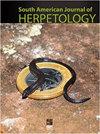Evaluation of the Seasonal Variation of Parameters of Oxidative Status of Tropidurus catalanensis Gudynas and Skuk, 1983
IF 0.7
4区 生物学
Q4 ZOOLOGY
引用次数: 1
Abstract
Abstract. Markers of oxidative status may become important tools in conservation biology as a means of evaluating survival and reproductive expectations in organisms, as well as to elucidate the effects of anthropogenic impacts on populations living in their natural environments. The objective of the present study was to evaluate seasonal variations in oxidative status in a population of Tropidurus catalanensis through the analysis of lipid peroxidation levels and quantification of activity of the antioxidant enzymes superoxide dismutase, catalase, and glutathione S-transferase in liver, kidneys, and tail muscle. This lizard inhabits southern Brazil, in the Pampas grasslands. A total of 73 animals were collected over a 1-year period through active search and hand capture, separated into males and females, euthanized with ketamine hydrochloride, and frozen. A detailed approach on the variation of climatic variables over the seasons is also provided in order to subsidize a better comprehension of seasonal variation in oxidative stress biomarkers of T. catalanensis. Results obtained reveal that this lizard exhibits a clear pattern of seasonal variation in redox balance markers across different tissues. Antioxidant system of these animals is highly efficient, being able to maintain constant levels of lipid peroxidation in liver and muscle in males and in all tissues studied in females. In the renal tissue, an increase in lipid peroxidation was found only in males in spring. The enzymatic antioxidant defense system studied herein exhibited tissue and sex-specific responsiveness, and was possibly modulated by factors both abiotic (e.g., photoperiod, temperature, radiation, precipitation) and biotic (e.g., reproductive cycle, nutritional status, type of food consumed).对卡塔兰Tropidurus catalanensis氧化状态参数季节性变化的评价
摘要氧化状态标志物可能成为保护生物学中的重要工具,作为评估生物体生存和繁殖期望的手段,以及阐明人为影响对生活在自然环境中的种群的影响。本研究的目的是通过分析肝脏、肾脏和尾部肌肉中的脂质过氧化水平和抗氧化酶超氧化物歧化酶、过氧化氢酶和谷胱甘肽S-转移酶的活性,来评估热带木种群氧化状态的季节变化。这种蜥蜴栖息在巴西南部的潘帕斯草原上。在一年的时间里,通过主动搜索和手抓共收集了73只动物,分为雄性和雌性,用盐酸氯胺酮实施安乐死,并冷冻。还提供了气候变量随季节变化的详细方法,以帮助更好地理解梓木氧化应激生物标志物的季节变化。研究结果表明,这种蜥蜴在不同组织中表现出明显的氧化还原平衡标志物的季节变化模式。这些动物的抗氧化系统是高效的,能够在雄性动物的肝脏和肌肉以及雌性动物的所有组织中保持恒定水平的脂质过氧化。在肾组织中,脂质过氧化的增加仅在春季的雄性中发现。本文研究的酶促抗氧化防御系统表现出组织和性别特异性反应性,可能受到非生物因素(如光周期、温度、辐射、降水)和生物因素(例如生殖周期、营养状况、食用食物类型)的调节。
本文章由计算机程序翻译,如有差异,请以英文原文为准。
求助全文
约1分钟内获得全文
求助全文
来源期刊
CiteScore
1.50
自引率
0.00%
发文量
10
期刊介绍:
The South American Journal of Herpetology (SAJH) is an international journal published by the Brazilian Society of Herpetology that aims to provide an effective medium of communication for the international herpetological community. SAJH publishes peer-reviewed original contributions on all subjects related to the biology of amphibians and reptiles, including descriptive, comparative, inferential, and experimental studies and taxa from anywhere in the world, as well as theoretical studies that explore principles and methods.

 求助内容:
求助内容: 应助结果提醒方式:
应助结果提醒方式:


